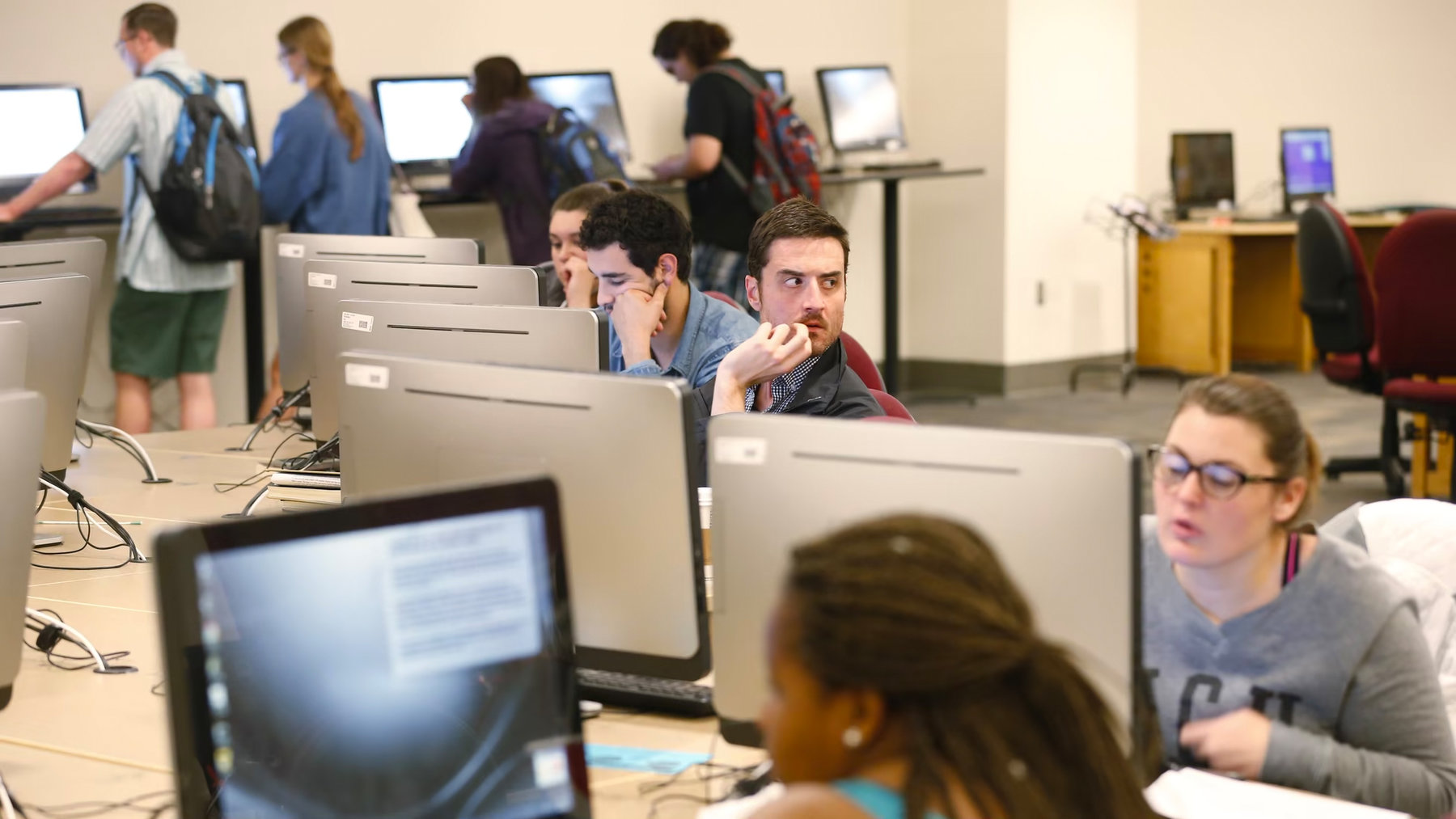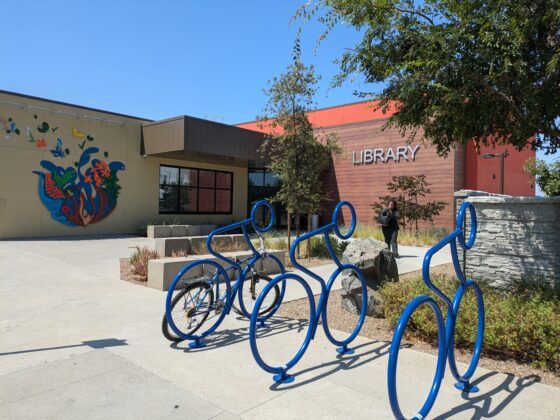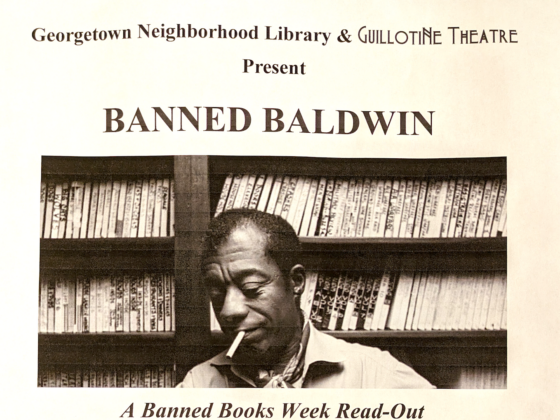Across Franklin County, which surrounds the city of Columbus, Ohio, civic-minded partners from government, business, education, and the nonprofit world have been collaborating on the newly-timely topic of digital equity. For years people have known that broadband connectivity, which in theory could equalize opportunities, has in many cases had the opposite effect. The past year of pandemic has dramatized the importance of fairer internet access—and the surprising new roles that American libraries are assuming.
This is a report about how that drama is playing out in one sizable American city, and what its lessons indicate for the country as a whole.
We all understand the costs of digital inequity better now that we have seen first-hand how the pandemic has affected the digital requisites of people’s lives. Pick a topic: the virtual education of students, access to hospitals and health care, securing appointments for vaccinations, applying for unemployment benefits, PPP, or CARES relief. The list is long and personal.
The Columbus Metropolitan Library system (CML) has been an important driver in long-term planning for the digital life of citizens before, during, and what will one day be life after COVID-19. And for the library itself, understanding their current roles and imagining their future roles in the entire scheme is part of their own particular effort.
Over the past few months, I have spoken by phone with three managers of branch libraries in Columbus, with administrators in the Columbus library system, and with people in the Urban Libraries Council, which also works on these issues. We also used ArcGIS software from Esri, the geospatial mapping company based in Redlands, California, to create three interactive maps that offer another perspective of the digital culture of libraries. (Note: Esri is a long-time partner and supporter of our use of maps to promote “geo-journalism,” dating back to my husband, Jim’s, advocacy of advanced mapping literacy for journalists at the international Esri User Conference in 2013.)
Broadband and computers, critical to all libraries, fit into the ecology of libraries in different ways, depending on the demographics, the wants and needs, and technological experience of their customers. Here are three examples.
The Hilltop—a library, a community hub, and a tech center:
John Tetzloff is the manager of the Hilltop branch of CML in the southwest section of the county. The Hilltop is a middle- and lower-middle-class neighborhood, of tightly packed housing, with big segments of deep poverty. Tetzloff described its melting-pot history, which began with an early influx of Vietnamese refugees in the 1970s. Then followed immigrants from Mexico and elsewhere in Latin America, and in the 1990s came a wave of professional-class Somali immigrants. In the 2000s came the agrarian Somali Bantus, many of whom had waited a decade in refugee camps for their chance to settle in America. The Hilltop has seen considerable second-wave immigration from around the U.S. And there have been lots of undocumented people as well.
The Hilltop library functions as a rare and much-appreciated community hub. Pre-pandemic, 1,000 people a day would come there for books and movies, to read the papers, use computers, and attend programs. The kids came for homework help and summer programs. Service organizations and other community partners came too, to meet with clients about legal or social problems. “There are few if any other places people can go to be with community,” says Tetzloff, who has worked in a number of different libraries, and describes this one as a high-energy place. “I love it,” he says, not missing a beat.
The culture of the library pre-lockdown saw a steady stream of people who came to use the computers. They logged on for all kinds of reasons: recreational games, Facebook, YouTube, the transactional necessities of life like checking bank accounts, inquiring about medical issues, applying for benefits, and more recently, researching housing options in a market where costs have skyrocketed. “Not a day goes by without surprises,” Tetzloff says.
In a quickly changing digital environment, Tetzloff describes a neighborhood where lots of people are left behind. “People come in and are very unsure how to use computers. It is a lot of our job: How to use a mouse, use a computer, from square one.” Then he continues importantly, “Even kids. In conventional wisdom, kids are naturals; they’ve grown up with it. But in fact, our kids are not very good at technology. They know how to get to favorite games, look at videos. But they don’t have the slightest idea how to research a paper for school.”
These are the kids who haven’t grown up exposed to the internet, who have no access at home, who don’t have a parent who can teach them. For them, “the tech gap is getting worse, not better,” he said.
During the pandemic of course, it’s all gotten worse. Schooling in Columbus has been mostly virtual. The libraries have been open-closed-open-closed. “It’s becoming a blur,” says Tetzloff, trying to put dates on it. But then he recounted a conversation with a woman at his newly-reopened library a day or two before. “You know,” she told him, “I know things are getting better if the library opens. If the library is open —and I know you’re careful, smart—it’s getting closer to the end.”
Northern Lights, where the computers are always 100 percent full:
The Northern Lights branch library was romantically-named, I thought. But as hard as I have searched for the name’s origin, I couldn’t confirm whether the Northern Lights shopping center, the library’s original home, was named for the actual Northern Lights, or perhaps from some electric company in that shopping center. (Crowd sourcing please: Anyone out there have an idea?) The library is now a little north of the center of Columbus, in a community quite similar demographically to The Hilltop. Like other branch managers, the Northern Lights manager, Andrea Villanueva, whom I also spoke with by phone, finds hers unique.
The community is home to a variety of New Americans, a favored moniker for recent immigrants. African immigrants come from many countries, especially Somalia. There is also a strong Hispanic community. Villanueva, herself Hispanic, feels her ethnicity equips her to be culturally aware of her diverse community. The populations of English language learners will easily fill a class with 60 or 90 people. The homework helpers see three times as many children as even the next busiest branch. Big Somali families, with seven or eight children, place a high emphasis on education, and they comprise a large part of her population, Villanueva told me.
“All this makes what we do very different from other branches in the community we serve,“ she says. There is a compelling need for computers at the library. “Our computers are always 100 percent full,” says Villanueva. At Northern Lights, many people use them for anything document-related—printing, scanning, and faxing. There are lots of forms, which demand lots of one-on-one help from library staff to find and complete.
After the most recent COVID-driven library closure, people were at the door at 9 a.m., waiting for the library to reopen. The arc of the day moves from daytime to after-school to evening, which was the busiest time of all in the pre-COVID-19 era. The shutdowns were challenging as the library tried to continue services curbside and drive-through. And people would go to the parking lot with laptops to use the Wi-Fi. The library, like others, answered in other ways, too. They have a NetSupport system, where library staff could work one-on-one with customers, screensharing remotely, to help them through their issues. The library system was really good about innovating different ways to help the community, says, Villanueva, but it was hard, and it took patience. Language issues made remote help particularly demanding.
Hilliard, where the need for broadband access dominates:
Across town to the west, in the diverse but overall more affluent area called Hilliard, is the recently-opened Hilliard branch, a 63,000-square-foot renovated space that was originally built as a senior community center, which never actually opened. Creating people space was a priority, says branch manager Amy McLanahan. There is something for everybody, and families are a big part of it: a huge children’s area, a teen section, meeting rooms, study rooms where people work individually or collaboratively. Some people come in to work or go for coffee in the café, or take part in the programming. All of this makes the library viable as a community gathering place.
Computers are significant, but McLanahan describes a different role they play in Hilliard compared with what I heard from The Hilltop and Northern Lights. To extend this era’s medical metaphor, at Hilliard computers are more of a booster shot than a ventilator. In Hilliard, broadband is the thing. More people have their own devices, and bring them in to log on to the library’s Wi-Fi. Looking around the study tables and into the small meeting rooms, she says that everybody is using the Wi-Fi. Why? “Some can’t afford Wi-Fi, for sure.” Teenagers will come in with the iPads issued by their schools to use Wi-Fi they may not have access to at home.
McLanahan goes through the litany of other reasons people come to the library: It is crowded at their houses, they need a quiet place to work, they are lacking an office. Some will collaborate with others at the library. Others just want company.
McLanahan also talks about the range of ways the staff help people on computers. Some need help applying for jobs or unemployment or guidance through the basics. Others—not just the older crowd—need the tech training, how to navigate or use Excel.
On another level, people can Google the basics, but stop right there. For example, a typical request might be “I need X or Y; can you recommend me a book?” McLanahan says library staff can do much more than recommend books—they can connect people with resources they didn’t know existed, showing them databases, subscriptions, interactive courses they can take for training or certification.
To tell these stories in a different, visual way, we have used Esri technology to create three interactive maps that include data from the 22 branches in the CML system.
The first map shows the amount of computer use in the different library branches, varying with neighborhood income levels. Not surprisingly, people in branches located in less affluent areas used the library’s public computers more often than people in branches in more affluent areas. Here’s what to look for and here’s how you can explore the maps for yourself:
- In the map’s background colors, dark blue represents the areas’s highest income households. In descending order of income levels, grey background is next, then white, light green, and dark green.
- Each circle represents a library branch. The size of the bright yellow of the circle shows the number of people who visit the library annually; the bigger the yellow circle, the greater the number of visitors. The size of the pink circle shows the number of sessions recorded by the computers; the bigger the pink circle, the greater the number of sessions per computer.
- If you click on the two arrows in the upper left of the map, the legend will pop up. If you click on a library, a set of pop-up bubbles offer geographic and demographic information for that branch. You can click through screens of information in the bubble including data for this map; the breakdown of income levels in the geographic tracts around the branch; and more.
For example, on this map, Hilliard, the big branch within a relatively affluent area of Columbus, is the westernmost circle. The big size of the yellow circle indicates the high number of visitors; the bubble will tell you those numbers exactly. The inner circle (a pink overlay on the yellow) shows relatively moderate use of the computers.
By contrast, the Hilltop branch (southwesternmost circle) and the Northern Lights Branch (north-central), in relatively less affluent neighborhoods show a relatively higher use of each library computer.
The second map shows the amount of computer use in different library branches, varying with the number of households in the area that have computers at home. The load on the branch’s computers is higher where fewer households have home computers.
- In the map’s background color, the darker the shade of red, the greater the number of households with computers; the lighter the color, the fewer households that have computers.
- As with the previous map, the size of the yellow ring represents the number of annual visitors to the branch. The size of the green ring represents the number of sessions on each computer.
- The pop-up bubbles show the percentage and the raw numbers of households without home computers for the tracts surrounding the library’s location.
In general, the libraries in areas where fewer households have computers at home, the greater the load on the libraries’ computers.
The third map shows the use of the public Wi-Fi when people brought in their personal devices to the library. Again, not surprisingly, and in accordance with comments from the library staff, the Wi-Fi carries a heavier load in libraries where more people bring in their personal devices.

- The purple rings show the load on the public Wi-Fi; the orange rings show the load on the library’s computers.
Spotlighted by the pandemic, the scope and breadth of the need for computers and broadband access are recognized as bigger than the libraries alone can cover. In Columbus, local partners are addressing this together. Around Columbus, for example, the library has been working with partners at the Franklin County Digital Equity Coalition, including those from the Columbus Foundation to the YWCA, among many others. Here is their new report.
And breaking news: The federal government, via the FCC, has approved emergency broadband benefit to help pay for people’s internet service. And the $1.9 trillion American Rescue Plan includes $7 billion to help students secure internet access. These are steps.
As libraries continue to examine their role in digital life, they recognize that one of their critical and unique weapons is the hands-on, brains-on human capital of the librarians and library staff. They have been helping people research and navigate through their online lives for a long time. With libraries’ well-earned and precious reputation as a trusted place with trusted people, libraries are in a position to augment and ramp up these efforts.
Besides partnering with local organizations of all sorts, libraries are scaling up digital training at many levels, surrounding it with education and counsel. And libraries are building new dedicated spaces where they can offer classes to reach more customers more effectively. Northern Lights already has a learning space. The Hilltop will, too, when their new building opens.
All these efforts are ways that public libraries are addressing huge needs, making it possible for all citizens to partake in the internet, which Patrick Losinski, the CEO of the CML calls “the fourth utility.”
Amy McLanahan brings the national topic of digital equity and libraries’ role in it right down to the human experience, “We level the playing field for people. We can’t make it equal, but we can make it so someone has what they need to become successful.”




